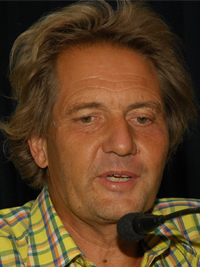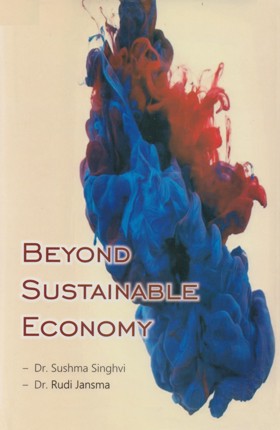Meeting Acharya Mahapragya in Rajamand (Rajasthan) during an International Conference on Peace and Noviolent Action organized by Anuvibha ('Small-vow Internatial Organsation') and listening to his Words, reading his books, and especially understanding, all the way through, what happens with one's mind, the actual Ahimsa path of transformation of heart and thus of mankind itself were among life term achievements for me. The post-Gandhian career of non-violence appeared as a global re-foundation of urgent ahimsa practice, from a non-violent life style to economics - e.g. hunger and poverty as sources of violence - and spirituality in the light of Ahimsa Prashikshan. Instead of formal declarations we shared, tens and thousands of us, an intimate, almost silent consciousness change helped by most qualified trainers, under the guidance of Acharya Mahapragya and [then] Yuvacharya[1] Mahashraman.
As a Romanian, I tried to spread the teachings of Rajsamand in Romania. Back home I wrote a micro-novel - The Orissa Woman. Jain Poem - and I did a research on Ahimsa in Romanian literature - from the ancient ballad Mioritsa/ The Little Lamb/ Memna (in Hindi) to the new Romanian Heysichasm[2], rereading poets like Mihai Eminescu, Lucian Blaga, Vasile Voiculescu with the ahimsa-key. Before Rajsamand I lectured, at Delhi University, on Mircea Eliade's Centenary in the World, mentioning that he has introduced the ahimsa concept in Romania and commented Mahatma Gandhi's non-violent revolution.
Mihai Eminescu (1850-1889) rewrote in Romanian on his own the beginning of the world from a sparkling point, as in the Nasadya Sukta. Even a violent birth of the cosmos has to be challenged. I wish Eminescu were in Rajsamand and coulf have seen the tenth Terapanth Ācārya, Mahāprāgya as a confirmation of his holy visions.
Climbing the Hill with thoughts directed to the Tirthankaras and to the Terapanth[3] Jains. some of us got an increased feeling of Christmas on 25th December, a few days after the organizer, Dr. S.L. Gandhi, made our growth through Rajsamand encounter, a landmark in our way to better humanity, once more clear. Rudi Jansma sent here his Introduction to Jainism. Mezaki found similarities between Shinto and Dacian Zalmoxe. Gabriela spoke of enthusiasm in Rajsamand. Thomas Daffern reformulated his interfaith statement.
Vinod Jain wrote me a letter and when back in Bucharest I received from the editors - P.V. Rajagopal and S. Jeyapragasam - the book Ahimsa - Nonviolence - International Gandhian Institute for Nonviolence and Peace, Madurai, May-June 2007, including articles Economics of Nonviolence and Peace by Acharya Mahapragya, and 'The Nonviolent Revolution - the Italian who embraced Gandhi's Satyagraha to oppose Fascism and War-II' by Rocco Altieri.
"The search for spiritual salvation did not require Gandhi to retire to a cave as a hermit, for he carries the cave with him" (A. Capitini[4])
The Romanian priest and scholar Constantin Galeriu speaks of Mahatma Gandhi as the only leader of revolutions who discovered the Saviour - through the Sermon on the Mount's preaching that stimulates one to love one's enemies. He proved to his enemies that he loved them, even while dying as a martyr. In the Mahatma's own words: "I think only the evil should be hated, not evil-doers, even when I could be the victim"; "Not to admit, and to detest your enemies' mistakes, should never rule out compassion and even love for them."
The same spirit was shared recently in Romania by the author[5] of Gandhi: The Man, his eople and the Empire. "What is freedom?" probed one student after an address by Rajmohan Gandhi's at a university in Baia Mare - a northern Romanian city of 130,000 people that was once a major mining center. Rajmohan Gandhi replied: "If the state tells me what to do, I say I will resist. But if my conscience asks me not to do something, I want to obey it. Then I find I have inner freedom."
For the students, and the university audience, R. Gandhi highlighted some key points:
- If you're planning a strategy for a community or country, leave absolutely no-one out.
- Have the courage to speak the truth to your own side.
- Think a lot but also leave room for inspiration.
- "If you find hatred around you, fight it. If people are hating each other, reconcile them. If someone is hating you, forgive him."[6]
On a blog on internet, the Romanian poet Ion Burhan sees in Gandhi's satyagraha a way to make people conscious of some 'social sins' of the Romanian society such as: richness without work, pleasure without conscience, knowledge without character, gain without morals; science without humanism, religion without personal sacrifice, politics without principles.
On the site of Bibliotheca Publishing House (May 2011) the most recent book on Jainism issued in Romanian translation: Introducere in Jainism by Rudi Jansma and Sneh Rani Jain is announced. 'Ahimsa - the heart of Jainism', 'Gandhi - modern apostle of Jainism' and 'Karma' are among the key words of this presentation for general public.[7]
References
Anca, George: The Orissa Woman. Jain Poem.
Jansma, Rudi & Sneh Rani Jain: Introduction to Jainism. Jaipur, Prakrit Bharati Academy, 2006.
Jansma, Rudi & Sneh Rani Jain: Introducere in Jainism.
Rajagopal, P.V. and S. Jeyapragasam (Eds.): Ahimsa - Nonviolence. Madurai, International Gandhian Institute for Nonviolence and Peace, 2007.
Jaini, Padmanabha: The Jaina Path of Purification. Motilal Banarsidas, Delhi, 1979.
Acharya Mahaprajna, Anekanta: The Third Eye. Jain Vishva Bharati, Ladnun RJ, India, 2002.
Umasvati, That Which Is: Tattvartha Sutra, translated by Nathmal Tatia. Harper Collins, San Francisco and London, 1994.
Pal, Pratapaditya, The Peaceful Liberators: Jain Art from India. Los Angeles County Museum of Art, Thames and Hudson, New York and London, 1995
Alphen, Jan van, Steps to Liberation: 2500 Years of Jain Art and Religion. Etnografisch Museum Antwerp, Belgium 2000.
Heysichasm (Greek: hesychasmos) means stillness, rest, quiet, silence, and is a mystical tradition of prayer in the Christian Eastern Orthodox Church
The Terapanth ('path of the thirteen') is a religious sect within ©vetåmbara (white-clad, as distinct from the sky-clad) Jainism, founded in Rajasthan in 1760 by Muni Bhikhan (Bhikshu Swami), who later became Acharya Bhikshu (...cårya Bik¼u). The Terapanthi order is strongly against devotion to icons and temple worship.
Aldo Capitini (1899 1968) was an Italian philosopher, poet, political activist, anti-Fascist and educator. He was one of the first Italians to take up and develop Mahatma Gandhi's theories of nonviolence and was known as 'the Italian Gandhi' (Wikipedia)
The English version of the book is available from the publisher: Prakrit Bharati Academy, Jaipur India, Rajathan: [email protected]; also readable free online at www.HereNow4U.net.
 Dr. Rudi Jansma
Dr. Rudi Jansma
 George Anca
George Anca
